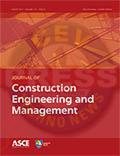Abstract
Construction projects are known as high-risk projects due to their complex and dynamic nature. The probability of success of construction projects is increased with efficient management of key risks. Understanding and selecting risk-response strategies is an essential step in the risk management process, which plays a crucial role in reducing the probability and impact of risks.
Moreover, risk interdependencies play a pivotal role in deciding about risk-response strategies. On the other hand, the implementation of any response may impose a cost on the project, which the project team should be aware of in all phases of the construction project.
Existing risk-assessment methods often do not consider the risk interdependencies and the role of risk-response strategies in reducing project risk exposure. Besides, the lack of data in construction projects hampers the use of risk-assessment methods.
Bayesian networks (BNs) can reduce some of these limitations. The research aims are to provide a Bayesian-based model to assess the probability of project failure considering risk interdependencies and the role of risk-response strategies in reducing project risk exposure.
The cost of implementing risk-response strategies to help decision-makers in selecting from different responses is also calculated. Moreover, in order to validate the model and explain the procedure of implementing it practically, it was implemented in a construction project case study.
The result of the model implementation for the case study showed that by allocating about 2% more money on implementing risk-response strategies than in the basic scenario (without entering observations), the probability of project failure was reduced about 60%. Moreover, when the total cost of implementing risk-response strategies was increased dramatically, the probability of project failure did not necessarily decrease because the most expensive risk-response strategy may not the best one.
The proposed model provides the best combination of risk responses by minimizing the probability of project failure and the cost of implementing risk responses.

